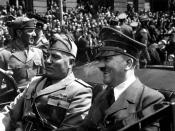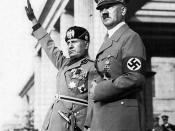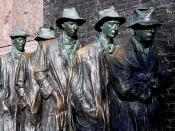A Good Grade Essay on a Good Topic!!! Very Interesting.
The Great Depression
All these changes affects the society in different ways .The Great Depression caused many people to destruct businesses and led the government to regulate the businesses and economic affairs. All this increased regulation led to the widespread belief that the government should promise or guarantee citizens a good life, and high employment. After the depression, many people no longer trusted employers to protect workers.
As a result labor unions gained more members and grater public acceptance then ever before. Depression makes some people lose there faith in government which then brings them to not believe anybody who promises a change.
Can anyone tell me who you think was the two leaders that actually took part during the depression was? (show overhead of the fifth paragraph) Leaders who actually took power during the depression were Adolph Hitler and Benito Mussolini who of which was the dictator of Italy from 1922 to 1943 just like Hitler was dictator of Germany from 1933 to 1945.
Relation between the nations suffer during a depression. Basically each country tries to protect its own interests without concerns of other nations.
Depression hurt a lot of people, especially working people who lose there jobs. Bank failures clean out some depositors savings if funds are not ensured. When there was the depression, most people can not meet the house or apartment payments so they lose there homes and become homeless.
During a depression some people must live on charity just to support themselves and there families. Sometimes the people who get the charity money, clothes, and food get kind of embarrassed that they need the money and they feel ashamed that they can't afford to support themselves which is basically not their fault. The Great Depression caused lots of marriages and birth rates to decline. If you were a younger person and you didn't have a job you would delay your wedding until you have enough money to pay for it just because of the depression. Most of the time when your unemployed for a long time you lose faith in yourself and in the future. After a depression many people value security more than anything else.
Some people profit from the depression, like people with enough money can buy businesses, stocks, or other property for a very low price.
From what I hear economists disagree on what causes depressions and how they are or can be prevented .Some economists believe that psychological factors such as peoples optimism or pessimism, determine decisions to save or spend.
Several theories maintain that population changes or inventions cause periods of expansion and contractions-(depression or recession). When immigration or higher birth rates cause a population to grow, demands tends to increase.
When population growth slows down, demands drop by huge amounts. Such inventions as the automobile and color television spur business investments and consumer spending, causes expansion. After demand for these products has been satisfied, spending drop offs resulting in contraction. Still other theories suggest that during expansion, business invest too heavily in buying.
The expanded role of the federal government came to be accepted by most all Americans by the end of the 1930's. Even republicans who had bitterly opposed the new deal shifted there stance.
Wendle Wilkie the republican president nominee in 1940 declared that he couldn't oppose reform such as regulation of the security markets and the utility holding companies, the legal recognition of unions, or social security and unemployment allowances. What bothered him so much and not just him but other critics was extensions of the federal bureaucy. In March of 1933 president Roosevelt declared 'There is nothing to fear but fear itself.'
The great depression was the worst economic slump ever in the U.S History, and one which spread to virtually all of the industrialized world. ( show second paragraph of overhead) However, the main causes for the depression was the combination of the greatly unequal distributions of wealth throughout the 1920's, and the extensive stock market speculation that took place during the latter part that same decade. The maldistribution of wealth in the 1920's existed on many levels. Money was distributed disparately between the rich and the middle - class, between industry and agriculture within the United States, and between the U.S. and Europe. This imbalance of wealth created an high, but eventually lead to large market crashes. These market crashes, combined with the maldistribution of wealth, caused the American economy to capsize.
Another main cause of the great depression happened during the roaring twenties. The 'roaring twenties' was an era when our country prospered tremendously. The nation's total realized that the income had rose from 74.3 billion dollars in 1923 to 89 billion dollars in 1929. However, the rewards of the 'coolidge prosperity' of the 1920's were not shared evenly among all Americans. According to a study done by the Brooking Institute, in 1929 the top .1 percent of Americans had a combined income equal to the bottom 42 percent. That same top .1 percent of Americans in 1929 controlled 34 percent of all savings, while 80 percent of Americans had no savings at all. ( show third paragraph of overhead) This might have sounded very confusing so I made an overhead showing what I explained.
A major reason for this large and growing gap between the rich and the working - class people was that the increased manufacturing output throughout this period. From 1923 - 1929 the average output per worker increased 32 percent in manufacturing. During that same period of time average wages for manufacturing jobs increased only 8 percent. Thus, wages increase at a rate as fourth as fast as productivity increased. As production costs fell quickly, wages rose slowly, and prices remained constant, the bulk benefit of the increased productivity went into corporate profits. In fact, from 1923 - 1929 corporate profits rose 62 percent and dividends rose 65 percents.
The large and growing disparity of wealth between the well - to - do and the middle - income citizens made the U.S. economy unstable. This made the economy function poorly which also lead to the great depression. For an economy to function properly, total demand must equal total supply. In an economy with such disparate of income it is not assured that demand will always equal supply. Essentially what happened in the 1920's was there was an oversupply of goods. It was not that the surplus products of industrialized society were not wanted, but rather that those whose needs were not satisfied could not afford more, whereas the wealthy were satisfied by spending only a small portion of their income.
( show overhead of fourth paragraph) Through such a period of imbalance, the U.S. came to rely upon two things in order for the economy to remain on an even keel which helped to decrease the chances of going through the depression: credit sales, and luxury spending and investment from the rich.
One obvious solution which might have stopped the depression was to let those who wanted goods to buy the products on credit. The concept of buying now and paying later caught on quickly. By the end of the 1920's, 60 percent of cars and 80 percent of radios were bought on installments credit. Between 1925 and 1929 the total amount of outstanding installment credit more than doubled from 1.38 billion dollars to around 3 billion dollars. Installment credit allowed on to 'telescope the future into the present', as the president's committee on Social Trends noted. This strategy created artificial demand for products which people could not ordinarily afford. It put off the day of reckoning, but it made the downfall worse when it came. By telescoping the future into the present, when the 'future' arrived, there was little to buy that hadn't already been bought. In addition, people could no longer use their regular wages to purchase whatever items they didn't have yet, because so much of the wages went to paying back past purchases.
The U.S. economy was also reliant upon luxury spending and investment from the rich to stay afloat during the 1920's. The significant problem with this reliance was that luxury spending and investment were based on the wealth's confidence in the U.S. economy. If conditions were to take a downturn ( as they did with the market in fall and winter 1929) , this pending and investment would slow to halt. While savings and investment are important for an economy to stay balanced, at excessive levels that are not good. Greater investment usually means greater productivity which were not being distributed equally, the problems of income distribution were only made worse. Lastly, the search for ever greater returns on investments lead to wide - spread market speculations.
So far, all these causes of depression might not be familiar with you but, they could affect the economy in great ways and that is why the Us. Economy has studied these causes so that they are prepared for the future. All of the causes that I have listed above are just the few causes to the Great depression. In fact, there are lots of other minor or major causes. Can anyone at least name one cause. (show overhead of main causes).
To understand the Great Depression, it is important to know the theories of John Maynard Keynes. (show overhead of sixth paragraph) Keynes is known as the 'Father of modern Economics' because he was the first to accurately describe some of the causes and cures for recessions and depressions.
In a normal economy, Keynes said, there is a circular low of money. MY spending becomes part of your earnings, and your spending becomes a part of my earnings. For various reasons. However, this circular flow can falter. People start hoarding money when times become tough; but times become tougher when everyone starts hoarding money. This breakdown results in recession.
To get the circular flow of money started again, Keynes suggested that the central bank--in the U.S., the Federal Reserve System - should expand the money supply. This would put more money in people's hands, inspire consumer confidence, and compel them to start spending again.
A depression, Keynes believed, is an especially severe recession in which people hoard money no matter how much the central bank tries to expand the money supply.(show overhead of seventh paragraph) In that case, he suggested that government should do what the people were not: start spending. He called this 'priming the pump' of the economy. Indeed, most economists believe that only massive U.S. defense spending in preparation for World War II cured the Great Depression.
(Show overhead of Chart)
3.20 % Hoover era, Great Depression begins
24.9 FDR, New Deal begins; contraction ends, March
19. Recession begins, May
As you can see, Roosevelt began relatively modest deficit spending that arrested the slide of the economy and resulted in some astonishing growth numbers. When 1936 saw a phenomenal record of 14 percent growth. Roosevelt eased back on the deficit spending, overly worried about balancing the budget. But this only caused the economy to slip back into a recession, as the above chart shows.
I have been unable to find reliable economic growth figures from World War II, but as a generalization it is safe to say the economy exploded, experiencing it's greatest growth in the U.S history. Between 1940 and 1945, the GDP nearly doubled in size, form 832 billion dollars to 1559 billion dollars in constant 87 dollars. And this occurred as deficit spending soared, to levels Keynes had earlier and unsuccessfully recommended to Roosevelt.


